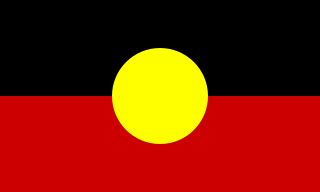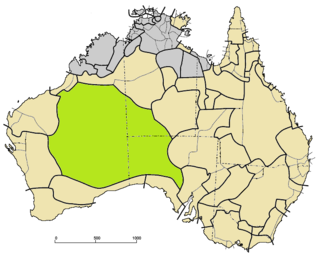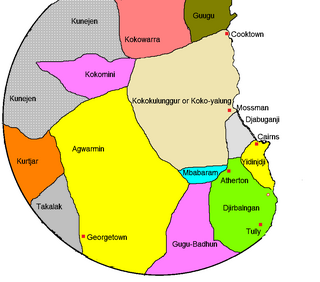Related Research Articles

The Indigenous languages of Australia number in the hundreds, the precise number being quite uncertain, although there is a range of estimates from a minimum of around 250 up to possibly 363. The Indigenous languages of Australia comprise numerous language families and isolates, perhaps as many as 13, spoken by the Indigenous peoples of mainland Australia and a few nearby islands. The relationships between the language families are not clear at present although there are proposals to link some into larger groupings. Despite this uncertainty, the Indigenous Australian languages are collectively covered by the technical term "Australian languages", or the "Australian family".
Many Australian Aboriginal cultures have or traditionally had a manually coded language, a signed counterpart of their oral language. This appears to be connected with various speech taboos between certain kin or at particular times, such as during a mourning period for women or during initiation ceremonies for men, as was also the case with Caucasian Sign Language but not Plains Indian Sign Language, which did not involve speech taboo, or deaf sign languages, which are not encodings of oral language. There is some similarity between neighbouring groups and some contact pidgin similar to Plains Indian Sign Language in the American Great Plains.
Australian Aboriginal English is a cover term used for the complex, rule-governed varieties of English used by a large section of the Indigenous Australian population as a result of colonisation. It is made up of a number of varieties which developed differently in different parts of Australia, and grammar and pronunciation differs from that of standard Australian English, along a continuum. Some of its words have also been adopted into standard or colloquial Australian English.

Aboriginal Australians are the various Indigenous peoples of the Australian mainland and many of its islands, excluding the ethnically distinct people of the Torres Strait Islands.

The Western Desert language, or Wati, is a dialect cluster of Australian Aboriginal languages in the Pama–Nyungan family.

The Dharug language, also spelt Darug, Dharuk, and other variants, and also known as the Sydney language, Gadigal language, is an Australian Aboriginal language of the Yuin–Kuric group that was traditionally spoken in the region of Sydney, New South Wales, until it became extinct due to effects of colonisation. It is the traditional language of the Dharug people. The Dharug population has greatly diminished since the onset of colonisation. The term Eora language has sometimes been used to distinguish a coastal dialect from hinterland dialects, but there is no evidence that Aboriginal peoples ever used this term, which simply means "people". Some effort has been put into reviving a reconstructed form of the language.
Pitta Pitta is an extinct Australian Aboriginal language. It was spoken around Boulia, Queensland.
Ngarrindjeri, also written Narrinyeri, Ngarinyeri and other variants, is the language of the Ngarrindjeri and related peoples of southern South Australia. Five dialects have been distinguished by a 2002 study: Warki, Tanganekald, Ramindjeri, Portaulun and Yaraldi.

The Nyungic languages are the south-westernmost of the Australian Aboriginal languages:
Indigenous Australians are people with familial heritage from, and/or recognised membership of, the various ethnic groups living within the territory of present day Australia prior to British colonisation. They consist of two distinct groups, which include many ethnic groups: the Aboriginal Australians of the mainland and many islands, including Tasmania, and the Torres Strait Islanders of the seas between Queensland and Papua New Guinea, located in Melanesia.

Gumbaynggir is an Australian Aboriginal language spoken by the Gumbaynggirr people, who are native to the Mid North Coast of New South Wales.
Bidjara, also spelt Bidyara or Pitjara, is an Australian Aboriginal language. In 1980, it was spoken by 20 elders in Queensland between the towns of Tambo and Augathella, or the Warrego and Langlo Rivers. There are many dialects of the language, including Gayiri and Gunggari. Some of them are being revitalised and are being taught in local schools in the region. The various dialects are not all confirmed or agreed by linguists.
Aboriginal Australian kinship comprises the systems of Aboriginal customary law governing social interaction relating to kinship in traditional Aboriginal cultures. It is an integral part of the culture of every Aboriginal group across Australia, and particularly important with regard to marriages between Aboriginal people.
Dhauwurd Wurrung is a term used for a group of languages spoken by various groups of the Gunditjmara people of the Western District of Victoria, Australia. Keerray Woorroong is regarded by some as a separate language, by others as a dialect. The dialect continuum consisted of various lects such as Kuurn Kopan Noot, Big Wurrung, Gai Wurrung, and others. There was no traditional name for the entire dialect continuum and it has been classified and labelled differently by different linguists and researchers. The group of languages is also referred to as Gunditjmara language and the Warrnambool language.
Yaygir, also spelt Yaygirr or Yegir, is an Australian Aboriginal language. It was spoken by the Yaygir people in the Northern Rivers region of New South Wales.
Guugu Yalandji, also spelt Kuku-Yalanji, is an Australian Aboriginal language of Queensland. It is the traditional language of the Kuku Yalanji people.
Biri, also known as Biria, Birri Gubba, Birigaba, Wiri, Perembba and other variants, is an Australian Aboriginal language of the Mackay area of Queensland spoken by the Birri Gubba people. There are at least eight languages regarded as dialects of Biri, and two which are related but whose status is not yet fully determined. All are covered in this article.

Wamin, also known as Agwamin or Ewamian, is an Australian Aboriginal language of North Queensland spoken by the Ewamian people. Wamin was traditionally spoken in the Etheridge region, in the areas around Einasliegh, Georgetown, and Mount Surprise.
Kalaamaya, also spelled Karlamay, is a Pama–Nyungan language of Western Australia. It is poorly attested, but appears to be a close relative of Noongar.
References
- 1 2 3 A95 Natingero at the Australian Indigenous Languages Database, Australian Institute of Aboriginal and Torres Strait Islander Studies